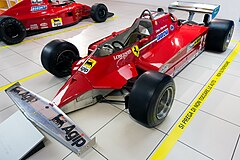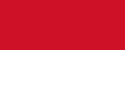Ferrari 126 CK
| |||
 Ferrari 126 CK w Gallerii Ferrari | |||
| Kategoria | Formuła 1 | ||
| Konstruktor | Ferrari | ||
| Projektant | Antonio Tomaini Mauro Forghieri (126 C2–126 C4) | ||
| Dane techniczne | |||
| Silnik | Ferrari 021 V6 t Ferrari 031 V6 t (126 C4) | ||
| Opony | Michelin, Goodyear | ||
| Historia | |||
| Debiut | Grand Prix Stanów Zjednoczonych – Zachód 1981 | ||
| Kierowcy | Gilles Villeneuve, Didier Pironi, Patrick Tambay, Mario Andretti, René Arnoux, Michele Alboreto | ||
| Używany | 1981-1984 | ||
| Mistrzostwa | |||
| Konstruktorów | 1982-1983 | ||
| Wyścigi | |||
| Wyścigi | 60 | ||
| Wygrane | 10 | ||
| Pole position | 10 | ||
| Najszybsze okrążenie | 12 | ||
| |||
Ferrari 126 CK – samochód Formuły 1 zaprojektowany przez Antoniego Tomainiego i skonstruowany przez Ferrari. Samochód był używany w sezonach 1981-1984. Ferrari 126 CK był napędzany przez jednostki Ferrari[1].
Do sezonu 1984 używane były kolejne wersje samochodu: 126 C2[2], 126 C2B[3], 126 C3[4] i 126 C4 zaprojektowane przez Mauro Forghieriego[5].
Wyniki
| Legenda oznaczeń w tabelach wyników Wyświetl szablon na nowej stronie | |
|---|---|
| Oznaczenie | Wyjaśnienie |
| Złoty | Zwycięzca lub mistrzostwo |
| Srebrny | 2. miejsce lub wicemistrzostwo |
| Brązowy | 3. miejsce lub II wicemistrzostwo |
| Zielony | Ukończył, punktował (w klasyfikacji generalnej, gdy zdobył co najmniej jeden punkt na przestrzeni sezonu, poza trzema powyższymi opcjami) |
| Niebieski | Ukończył, nie punktował (w klasyfikacji generalnej, gdy nie zdobył co najmniej jednego punktu na przestrzeni sezonu) |
| Czerwony | Nie zakwalifikował się (NZ) |
| Nie prekwalifikował się (NPK) | |
| Różowy | Nie ukończył (NU) |
| Niesklasyfikowany (NS) (w klasyfikacji generalnej, gdy nie został sklasyfikowany w żadnym wyścigu sezonu) | |
| Czarny | Zdyskwalifikowany (DK) |
| Wykluczony (WYK/EX) | |
| Biały | Nie wystartował (NW) |
| Kontuzjowany (K/INJ) | |
| Wyścig odwołany (OD/C) | |
| Bez koloru (domyślny #F8F8F8) | Został wycofany (WYC/WD) |
| Nie przybył (NP/DNA) | |
| Nie brał udziału w treningach (NT/DNP) | |
| Nie został zgłoszony (–) | |
| Pogrubienie | Start z pole position |
| Kursywa | Najszybsze okrążenie wyścigu |
| † | Nie ukończył, ale jego rezultat został zaliczony ze względu na przejechanie więcej niż 90% dystansu wyścigu. |
| * | Sezon w trakcie |
| Lista systemów punktacji Formuły 1 | |
| Sezon | Zespół | Silnik | Kierowcy | Wyniki w poszczególnych eliminacjach | Wyniki kierowców | Wyniki konstruktora | |||||||||||||||||
|---|---|---|---|---|---|---|---|---|---|---|---|---|---|---|---|---|---|---|---|---|---|---|---|
| 1981 | Pkt. | Msc. | Pkt. | Msc. | |||||||||||||||||||
| Scuderia Ferrari SpA SEFAC | Ferrari | NU | NU | NU | 7 | 4 | 1 | 1 | NU | NU | 10 | NU | NU | NU | 3 | DK | 25 | 7 | 34 | 5 | |||
| NU | NU | NU | 5 | 8 | 4 | 15 | 5 | NU | NU | 9 | NU | 5 | NU | 9 | 9 | 13 | |||||||
| 1982 | Pkt. | Msc. | Pkt. | Msc. | |||||||||||||||||||
| Scuderia Ferrari SpA SEFAC | Ferrari | NU | NU | DK | 2 | NW | – | – | – | – | – | – | – | – | – | – | – | 6 | 15 | 74 | 1 | ||
| 18 | 6 | NU | 1 | NW | 2 | 3 | 9 | 1 | 2 | 3 | NW | – | – | – | – | 39 | 2 | ||||||
| – | – | – | – | – | – | – | – | 8 | 3 | 4 | 1 | 4 | NW | 2 | NW | 25 | 7 | ||||||
| – | – | – | – | – | – | – | – | – | – | – | – | – | 3 | NU | 4 | 19 | |||||||
| 1983 | Pkt. | Msc. | Pkt. | Msc. | |||||||||||||||||||
| Scuderia Ferrari SpA SEFAC | Ferrari | 5 | NU | 4 | 1 | 4 | 2 | NU | 3 | 3 | NU | NU | 2 | 4 | NU | NU | 40 | 4 | 89 | 1 | |||
| 10 | 3 | 7 | 3 | NU | NU | NU | 1 | 5 | 1 | 2 | 1 | 2 | 9 | NU | 49 | 3 | |||||||
| 1984 | Pkt. | Msc. | Pkt. | Msc. | |||||||||||||||||||
| Scuderia Ferrari SpA SEFAC | Ferrari | NU | NU | 3 | 2 | 4 | 3 | 5 | NU | 2 | 6 | 6 | 7 | 11 | NU | 5 | 9 | 27 | 6 | 57,5 | 2 | ||
| NU | 11 | 1 | NU | NU | 6 | NU | NU | NU | 5 | NU | 3 | NU | 2 | 2 | 4 | 30,5 | 4 | ||||||
Przypisy
- ↑ Ferrari 126CK (ang. • fr. • hiszp. • niem. • wł. • port.). statsf1.com. [dostęp 2018-07-18].
- ↑ Ferrari 126C2 (ang. • fr. • hiszp. • niem. • wł. • port.). statsf1.com. [dostęp 2018-07-18].
- ↑ Ferrari 126C2B (ang. • fr. • hiszp. • niem. • wł. • port.). statsf1.com. [dostęp 2018-07-18].
- ↑ Ferrari 126C3 (ang. • fr. • hiszp. • niem. • wł. • port.). statsf1.com. [dostęp 2018-07-18].
- ↑ Ferrari 126C4 (ang. • fr. • hiszp. • niem. • wł. • port.). statsf1.com. [dostęp 2018-07-18].
Linki zewnętrzne
- Ferrari 126 CK na oficjalnej stronie zespołu (ang. • wł.). formula1.ferrari.com. [dostęp 2018-07-18].
- Ferrari 126 C2 na oficjalnej stronie zespołu (ang. • wł.). formula1.ferrari.com. [dostęp 2018-07-18].
- Ferrari 126 C3 na oficjalnej stronie zespołu (ang. • wł.). formula1.ferrari.com. [dostęp 2018-07-18].
- Ferrari 126 C4 na oficjalnej stronie zespołu (ang. • wł.). formula1.ferrari.com. [dostęp 2018-07-18].
Media użyte na tej stronie
The flag of Navassa Island is simply the United States flag. It does not have a "local" flag or "unofficial" flag; it is an uninhabited island. The version with a profile view was based on Flags of the World and as a fictional design has no status warranting a place on any Wiki. It was made up by a random person with no connection to the island, it has never flown on the island, and it has never received any sort of recognition or validation by any authority. The person quoted on that page has no authority to bestow a flag, "unofficial" or otherwise, on the island.
Flag of Brazil (1968-1992)
Autor: SanchoPanzaXXI, Licencja: CC BY-SA 4.0
Flag of Spain during the Spanish State. It was adopted on 11 October 1945 with Reglamento de Banderas Insignias y Distintivos (Flags, Ensigns and Coats of Arms Bill)
Flag of South Africa, also known as the Oranje-Blanje-Blou, used from 31 maja 1928 until 27 kwietnia 1994
Flag of Portugal, created by Columbano Bordalo Pinheiro (1857-1929), officially adopted by Portuguese government in June 30th 1911 (in use since about November 1910). Color shades matching the RGB values officially reccomended here. (PMS values should be used for direct ink or textile; CMYK for 4-color offset printing on paper; this is an image for screen display, RGB should be used.)


















